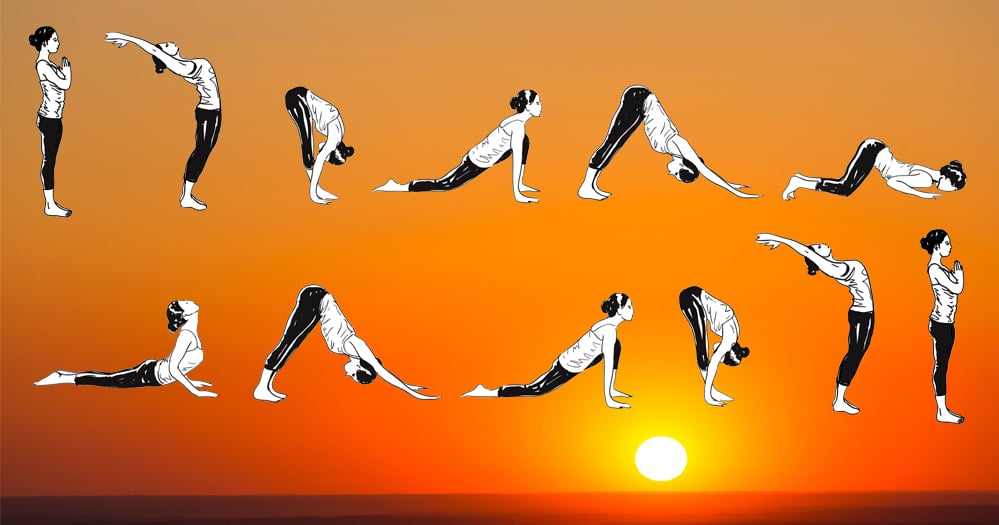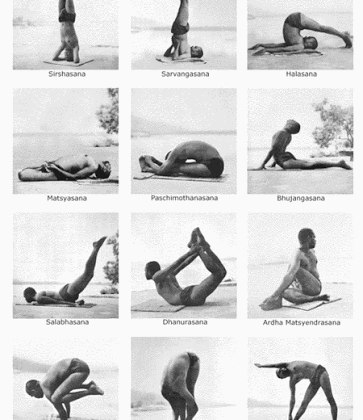Surya Namaskara The Sun Salutation
SURYA NAMASKARA THE SUN SALUTATION
AN INDISPENSABLE EVERYDAY PRACTICE
A wonderful sequence, but for new practitioners it often causes difficulty and bewilderment. I see people in the classroom looking left and right to find references on how to proceed, despite a detailed and precise guide.
The sequence of the twelve positions of Surya Namaskara, the Sunsalutation, begins with Namaskara Mudra, the gesture of greeting. Greeting in India is much more than just a wish, you get in tune, you perceive and share your conscience, you enter a sort of communion with the other.
Surya is the Sun, understood as the center of life and knowledge; the sequence of the Sun salutation becomes the possibility we all have to celebrate communion with Knowledge.
The practice of this sequence, which reproduces the solar parable with the body, from birth to sunset, is an ancient ritual of unknown origins, practiced with some postural differences by many peoples.
Body, mind and spirit receive from this practice a strong energy input, an awakening and an immediately perceptible well-being, as if solar energy consciously came to nourish every cell.
The best practice takes place outdoors (which alas is often not possible) by positioning yourself in front of the sun at sunrise and sunset, although in reality we can practice it at any time of the day and strictly with an empty stomach.
The number of sequences, which are practiced without interruption, varies from one to three or even more, as long as there is no body fatigue.
It is a complete practice that makes use of asanas (positions of Hatha Yoga), pranayama (conscious breathing) and mantra (repetitive sounds that lead to meditation).
Among the countless physical benefits we have a lengthening of the spine and muscles, all the muscles are strengthened, the lungs are filled with oxygen, the rib cage expands, a considerable amount of carbon dioxide and toxins are eliminated, the tone of the nervous system and memory increases, promotes sleep and reduces anxiety, normalizes endocrine gland activity, prevents skin imperfections, makes breasts more beautiful in women and improves pectorals in men, helps menstrual regularity, facilitates childbirth reduces body fat, improves bowel and kidney function and ultimately makes you long-lived.
HERE’S HOW IT’S DONE:

1) In an upright position with feet together (for those with spinal problems or back pain, keep the feet slightly apart) the hands join the chest as in prayer (Anjali-mudra), the head tilts slightly towards the sternum with dignified humility.
We look for the straight line of the back, with the pubis approaching the navel, thus stretching the lumbar area and the head in line with the bust. We take a deep breath, and as we exhale we chant the bija-mantra KHRAM or OM KHRAM MITRAYA NAMAHA
(greeting to everyone’s friend)

2) Breathing in we raise our arms beyond the head, stretching the whole body up towards the sky and then arching the back back with the buttock muscles a little contracted in order to defend the lumbar area so we open up to the sky, to the sun and to life.
On an esoteric level, bringing your arms up above your head opening up to the sky, this means expressing a YES to life

3) Exhaling we go down with the back very straight, placing our hands on the ground next to the feet (in case of back problems the knees will have to flex). The back together with the head should form a straight and continuous line. During the descent we can chant the bija-mantra KHRIM or OM KHRIM RAVAYE NAMAHA (greeting to him who shines)

4) Breathing in, bring the left foot a nice step back, placing the knee on the ground, the back arches and the gaze turns up towards the sky (with cervical problems we leave the head straight naturally).

5) Holding the air, we join the two feet behind bringing the whole body on a straight line from the shoulders to the heels. Keep your buttock muscles tight and activate your adominals to reach the straight line. The head continues the line of the bust.

6) On exhaling we first place the knees followed by the chest and finally the chin on the ground. In this position eight points touch the ground: feet, knees, hands, chest and chin. As we exhale and descend, we chant the bija-mantra KHRUM or OM KHRUM SURYAYA NAMAHA (greeting to the one who causes action)

7) Breathing in, we slide forward and elegantly lift the head and torso arching the back well, with the buttock muscles tightly contracted to defend the lumbar area. The gaze turns up towards the sky (with cervical problems the head remains straight with the cervical vertebrae extended).

8) Exhaling, we raise the pelvis pushing it as high as possible, with the abdominal muscles active as if we wanted to bring the navel to the column, we stretch and lengthen the back bringing it in the same line as the arms, so that the head and the neck area remain relaxed. While entering the position we chant the bija-mantra KHRAIM or OM KHRAIM SAVITRE NAMAHA (greeting to the loving mother)

9) Breathing in, bring the left foot forward between the two hands, arching the back and looking up at the sky.

Another variant is to bring the arms above the head. (Always consider that with cervical problems it is better to keep your gaze forward)

10) Breathing out, join the feet between the two hands, raise the pelvis as high as possible. By making room in the abdomen, we try to bring the head closer to the knees (with back problems this is done with the knees bent). On the way down we can chant the bija-mantra KHRAUM or OM KHRAUM ARKAYA NAMAHA
(I greet the one who is praiseworthy)

11) Breathing in, raise the whole torso and bring the arms in the gesture of greeting (Anjali-mudra) beyond the head stretching the back well.

12) Breathing out we bring the hands back to Anjali-mudra in front of the chest, the back straightens always looking for the straight line of the spine. In the exhalation we can chant the bija-mantra KHRAH or OM KHRAH BHASKARAYA NAMAHA
(I greet the one who leads to enlightenment)
We remain in this position waiting for the breathing and heartbeat to return to normal, and then repeat everything on the other side by bringing the right leg back, etc.
Remember that practice at home is important, but you should always turn to the guide of a qualified teacher, only then will it be possible to avoid errors during the exercise of the sequence.
Good practice then
as always with gratitude
Sabine
Categories
- Senza categoria (10)


